"Forget
You Not"™:
H o l o c a u s t
S u r v i v
o r s a
n d R e m e
m b r a n c e
P r o j e c t
- Part I -
|
 
T A B L E
O F
C O N T E N T S
 
|
|
< iSurvived.org >
|
|
< ForgetYouNot.org >
|
|

|

|
"In
a world of
absurdity, we
must invent
reason..."
Elie
Wiessel
|

|
|
I. Holocaust Background
Information: An Introduction
 
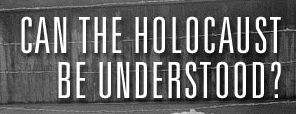
Whenever
a study of the Nazis is
undertaken, there is one
burning question that
emerges:
How could a cultured nation,
at the heart of Europe,
be responsible for acts
so horrible,
so inhuman?
.
|
1. Overviews
of the Nazi
Holocaust
|
|
2. Timeline
and Chronology
of
the Nazi Holocaust
|
|
3. Notable
Events Preluding
the Holocaust
|
4. The Jewish
Holocaust (the Shoah)
1939-1945
|
5. The
Children of the Holocaust
|
|
6. The
Infamous
Medical Experiments
|
7. European
Romanies/"Gypsies", Victims
of the Holocaust
--the Porrajmos
|
8. The
Handicapped,
Part of the
Final Solution
|
|
9. Nazi
Persecution of Homosexuals
|
10. Nazi
Holocaust in the Occupied
Europe
|
11. Forced
Slave Labor
|
12. The Nazi
Ghettos
|
13. The
Concentration and
Extermination Camps
|
14. Holocaust
Revealed Through Original,
Primary Evidence
|
"I
myself never shot
a single Jew; I
only
gassed them..." --Erich Gnewuch
|
15. Nazi
Plundering
|

  "Those of you
who may survive, bear
witness, let the world know
what has happened here." "Those of you
who may survive, bear
witness, let the world know
what has happened here."
-- Aleksander
Aronowich Pechersky (leader of
the Sobibor revolt, seconds
before the outbreak)
|
|
.
|
.
|
.
|
.
|
|
1.
Overviews of The Nazi
Holocaust --this Ultimate
Example of Man's Inhumanity to
Man
|
|
"Though
not all victims were Jews, all
Jews were victims." --Elie
Wiesel
|

..
|
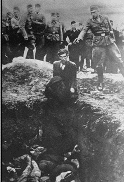
.A member of
Einsatzgruppe D
prepares to shot an Ukrainian Jew.


|
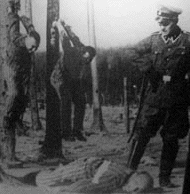
.The hanging
punishment of prisoners
at Buchenwald.
(The SS officer is
Buchenwald's chief warden,
Martin Sommer known as
the Hangman of Buchenwald. He
was responsible for the deaths
of hundreds of prisoners.).

|
|
|
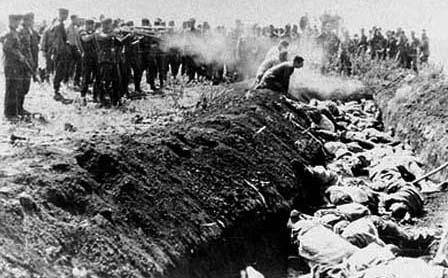 . .
The
Einsatzgruppen -- Mobile
Killing Units
|

|
  
2. Timeline and
Chronology of the Nazi Victimization
Process Culminating with the Holocaust


  
3. Notable Events
Marking the Beginning of the Holocaust:
|
Through
an orchestrated
policy of both
social and
economic
discrimination,
Jews were
increasingly
dehumanized and
isolated from
the mainstream
German
community. As
book-burning,
Aryanization of
Jewish-owned
businesses and
public
humiliation
became more
common, this
victimization of
their Jewish
neighbors was
viewed by the
general
population with
complacency or
even approval.
On
November 9,
1938,
Kristallnacht
(the Night of
Broken Glass)
began. A
supposedly
spontaneous
demonstration by
German citizens,
it was in fact
carefully
planned Pogrom
(Action against
Jews) and
resulted in the
destruction of
more than one
thousand
synagogues and
7,000 Jewish
owned
businesses, and
the arrest of
30,000 Jews. It
is generally
considered to
mark the
beginning of the
Holocaust. --Florida Holocaust Museum
|
|
|
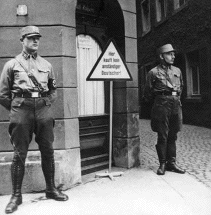
|
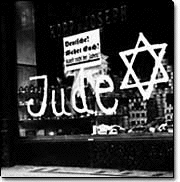
|
Picture
A
|
Picture
B
|
|
ANTI-JEWISH
LEGISLATION IN PREWAR
GERMANY
A).
Enforcing the German
Boycott
During
the April 1933 boycott, two
SA members guard the
entrance to a Jewish-owned
leather-goods shop.
The
sign reads "No
respectable German shops
here!"
B). All
Jewish Stores are being
marked in the Nazi Germany.
Additional
Source: U.S. Holocaust
Memorial Museum
<jewishvirtuallibrary.org/jsource/Holocaust/boycott1933.html>
|
|
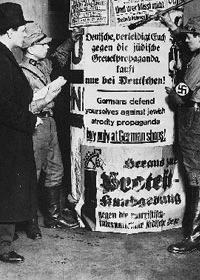
|
C).
Anti-Jewish boycott signs
SA storm
troopers pasting
anti-Jewish boycott signs
on a kiosk, Berlin, April
1933.
Photo
Credit: BPK
<www.holocaust-education.de/?site=pr_import_A007&lp=en>
|
|
Picture
C
|
|
|
|
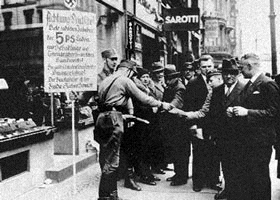
|
D).
SA pickets distribute boycott
pamphlets to German
pedestrians. The sign held
by one of them reads:
"Attention
Germans. These Jews (Five
and Dime Stores) are the
parasites and gravediggers
of German craftsmen. They
pay starvation wages to
German workers. The chief
owner is the Jew,
Nathan Schmidt."
Photo
Courtesy:
U.S. Holocaust Memorial
Museum
|
|
Picture
D
|
|
|
|
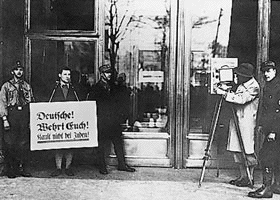
|
Anti-
Jewish Boycott, Dresden,
Germany (1933)
E).
SA members force a Jewish
merchant to wear a boycott
sign around his neck and
have his picture taken in
front of his store,
The sign reads:
"Germans
Defend Yourselves
- Do not buy from Jews!"
Photo
Credit: Peter Richard;
Sächsische
Landesbibliothek,
Deutsche Fotothek, Archive
no. 256039
|
|
Picture
E
|
|
|
|

|
F).
A German mass rally in 1935
featuring Anti-Semitic
speeches and slogans
stating:
"The
Jews are our Misfortune"
and
"Women
and Girls, the Jews are Your
Ruin."
<historyplace.com/pointsofview/goldhagen.htm>
|
|
Picture
F
|
|
|
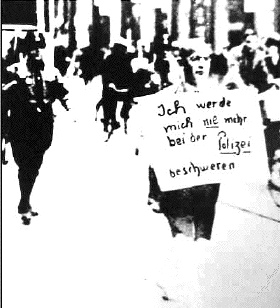
|
G).
Jewish lawyer carrying
self-Insulting sign
"I will not complain to the
police again."
NOTE:
A
new German law invoked a
clause to all Jewish
businesses stating that any
contract involving a Jew
would be terminated if the
man became incapacitated due
to illness. The German
court then ruled that his
racial characteristics of
being a Jew were considered
the same as illness and
therefore his contract was
no longer valid.
From
Yad Vashem Photo
Archives.
|
|
Picture
G
|
|
|
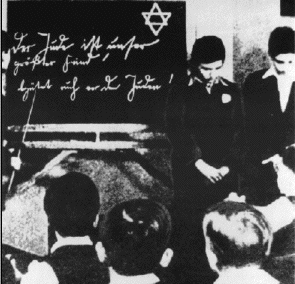
|
H).
Humiliation of Jewish
Children in the Schools
1935:
Jewish students are made fun
of by their class. The
writing on the blackboard
says,
"The Jew is our greatest
enemy!
Beware of the Jew!".
Source:
The Pictorial History of the
Holocaust,
Edited by Yitzhak Arad,
Macmillan Publishing
Company,
NY, 1990,
p.37.
<members.aol.com/dhs11/remember.html>
|
|
Picture
H
|
|
|
I). Writing
on the Wall. Vienna, 1938.
A young boy
is forced to paint "Jew"
on the wall of his
father's store.
Photo Credit:
AKG.
|
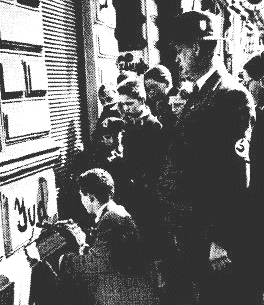
|
|
Picture
I
|
|
|
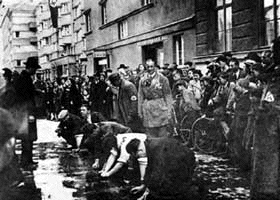
|
J).
Humiliation of Jews, Vienna
(March 1938)
After the
incorporation of Austria,
offenses against Jews
began there.
Jews are
forced to scrub the
sidewalks,
Courtesy:
Documentation
Archives
of the Austrian Resistance
Foundation,
Vienna.
|
|
Picture
J
|
|
|
|
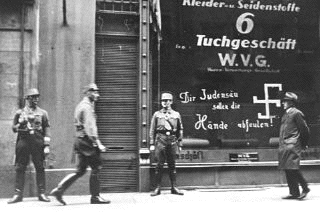
|
K).
In Vienna, Austria of 1938:
Shortly after
the German annexation of
Austria, Nazi Storm
Troopers stand guard
outside a Jewish-owned
business. Graffiti painted
on the window states:
"You Jewish
pig may your hands rot
off!"
Vienna,
Austria, March 1938.
Courtesy:
USHMM
|
|
Picture
K
|
|
Public Campaigns of
Humiliating Jews:
.
|
|
Jews
Forced To
Carry
Anti-Jewish
Signs
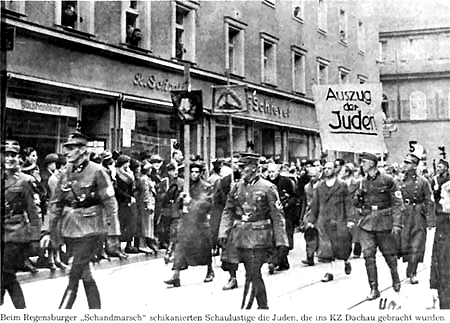
|
In
Nazi Germany,
Jews are being
paraded,
ridiculed, and
spitted on
as other
German
bystanders
watch the
spectacle.
(Nov. 1938).
Dr.
Andreas
Angerstorfer:
Jüdische
Gemeinde
Regensburg --
Die Geschichte
bis zum
<jg-regensburg.de/Geschichte2.html>
|
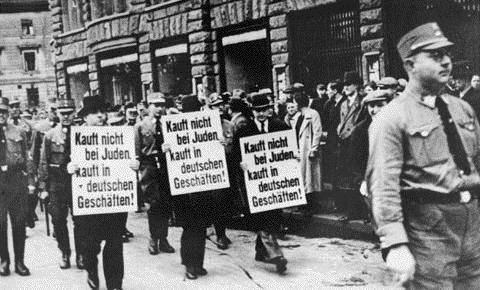
Jewish
businessmen are
forced to march
on Bruehl
Strasse, one of
the main
commercial
streets in
central Leipzig,
carrying signs
that read,
"Don't buy from
Jews. Shop in
German
businesses!"
1935.
Photo
credit: William
Blye Collection,
courtesy of
USHMM Photo
Archives
<fcit.usf.edu/holocaust/gallery/20210.htm>
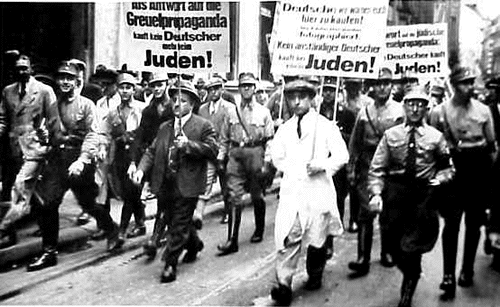
From
Yad Vashem
Archives -- The
Holocaust
Remembrance
Authority
Public
Humiliation of
Polish Jews
After
Germany invades
Poland in
September, 1939,
German soldiers
enjoyed the public
humiliation of
Polish Jews.
Humiliation was a
part of the
psychological
warfare that Nazis
used against Jews.
|
.
|
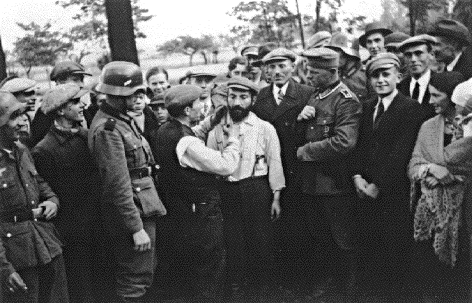
|
One
Jew is forced
to cut the
beard of
another under
German
supervision
as the local
population of
Tomaszow
Mazowiecki,
Poland,
watches with
delight.
|
Photo
Credit: Main
Commission for
the
Investigation
of Nazi War
Crimes,
courtesy of
USHMM Photo
Archives.
|
|
<fcit.usf.edu/HOLOCAUST/gallery/50978.htm>
|
|
.
|
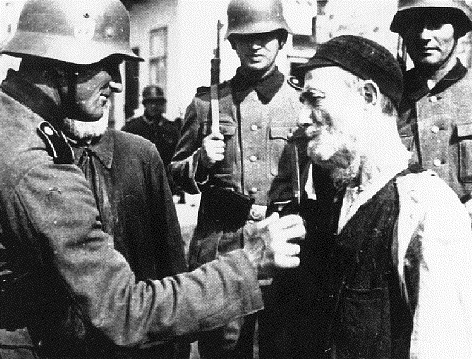
|
|
A
German soldier
is having fun
cutting the
beard of an
elderly Jew in
Poland.
|
Photo
credit: The
Pictorial
History of the
Holocaust,
Yitzak Arad,
Ed., Macmillan
Publ. Co.,
N.Y., 1990, p.
78,
<fcit.usf.edu/HOLOCAUST/gallery/Sh09.htm>
|
|
.
|
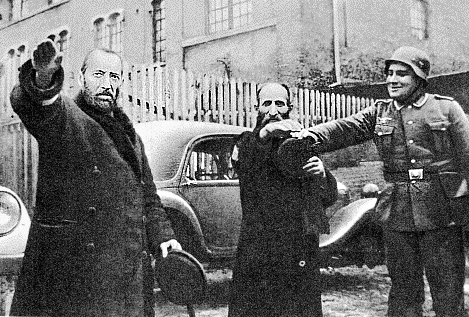
|
|
In
Poland, a
soldier tutors
two Jewish men
on how to give
the Nazi
salute
correctly.
|
Photo
credit:
Meczenstwo
Walka, Zaglada
Zydów Polsce
1939-1945.
Poland. No.
37.
<fcit.usf.edu/HOLOCAUST/gallery/p037.htm>
|
|
.
|
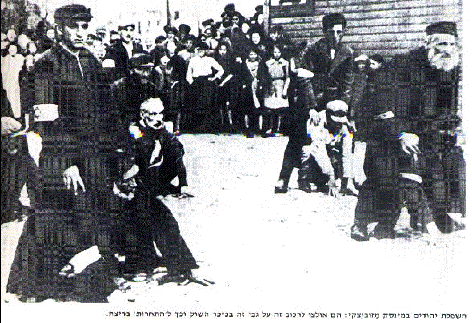
|
Jews
of Minsk
Mazowiecki,
Poland, forced
to ride on
each other
to "compete"
in running in
the Market
Square.
Source:
Encyclopedia
of the
Holocaust,
Editor: Israel
Gutman, Yad
Vashem, 1990,
Volume III,
Pp. 711-713
<zchor.org/minsk.htm>
|
.
|
.
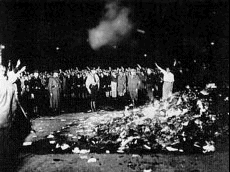
+Enlarge
this Image
|
May 10,1933:
Nazis burning "un-German" books
Some of the authors whose books were in the flames:
Bertolt
Brecht, Lion
Feuchtwanger,
and Alfred
Kerr were
consigned to
flames in a
book burning
ceremony in
Berlin. The
promotion of
"Aryan"
culture and
the
suppression of
other forms of
artistic
production was
yet another
Nazi effort to
"purify"
Germany. Other
writers
included on
the blacklists
were American
authors Ernest
Hemingway and
Helen Keller
as well as
Albert
Einstein,
Sigmund Freud,
Jack London,
Thomas Mann,
Upton
Sinclair,
H.G. Wells,
and
many others.
|
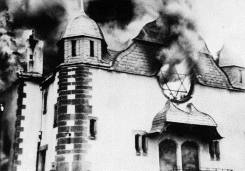
Kristallnacht
("The Night of
Broken Glass")
Night of
Nov. 9 -10,
1938.
|
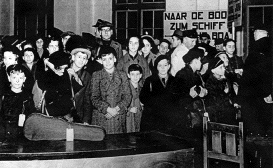
The
very first
Kindertransport (Children's Transport)
Dec.1,
1938
--
©KTA
|
|
|
|
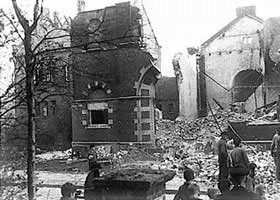
|
Oldenburg
Synagogue
Destroyed
(November
10, 1938)
The synagogue in Oldenburg the morning after the
Kristallnacht
pogrom.
Photo
Credit: Gustav
Meyer;
Copyright:
Private
Collection of
Magdalene
Meyer,
Oldenburg
<www.holocaust-education.de/?site=pr_import_A007&lp=en>
|
|
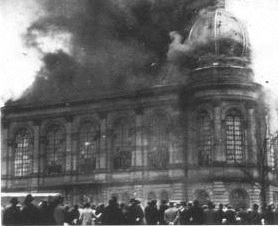
|

The Great
Synagogue of
Frankfurt,
Germany
Set on on Fire
(November
11, 1938)
Photo
Credit:
<bobi.net/helabo/projekte/antisem.htm>
|
|
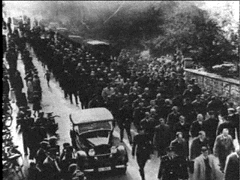
Kristallnacht:
A National
Pogrom,
Nov. 9-10,
1938
.
|
Arrest of Jews After Kristallnacht
After the Kristallnacht (Nov. 10, 1938),
the SS dragged
Jews through
the streets as
local Germans
ridiculed them
with
anti-Semitic
slogans. Jews
were first
brought to the
synagogue and
then
transported to
Dachau
concentration
camp.
Source:
Simon
Wiesenthal
Multimedia
Learning
Center
<motlc.wiesenthal.com/gallery/pg01/pg2/pg01283.html>
|
|
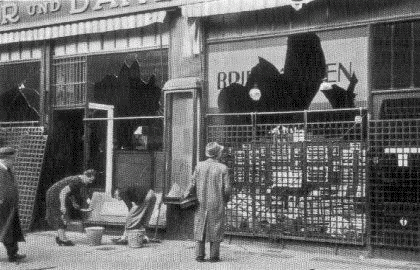
.Nazi
vandalization
of Jewish
owned
businesses
during the
pogrom of
Nov. 9-10,
1938
.
|
|
.
|
  
 4. The Jewish Holocaust
(the Shoah) 1939-1945 4. The Jewish Holocaust
(the Shoah) 1939-1945
|
"Once
I really am in power, my first
and foremost task will be the
annihilation of
the Jews..." --Adolf
Hitler --1922
|
|
.
|
|
|
|
[Photo
Credit:
www.um.oswiecim.pl/anniversary]
+ ENLARGE
PICTURE
|
|
|
The
Final Solution
|
|
Early
attempts to remove
Jews from Nazi
occupied Europe
included a plan
for resettlement
into a
"reservation" in
the Lublin-Nisko
region of
southeast Poland.
The first
transport to this
area took place on
October 26, 1939,
when 600 Jews from
Czechoslovakia
were relocated.
The final
deportation took
place in early
February of 1940.
An estimated
78,000 Jews were
deported to this
"reservation"
where there was
little or no
accommodation for
their needs. As a
result, thousands
died in the winter
of 1939-1940. The
program was
discontinued due
to the lack of
rail transport and
administrative
support.
|
|
In
the summer of
1940, the Nazis
began considering
a plan to remove
all Jews from the
continent and
relocate them on
the French
controlled island
of Madagascar. The
plan was
contingent on the
Nazi's ability to
have access to a
large fleet of
ships, which it
intended to
acquire through
victory over Great
Britain. It was
abandoned when it
seemed clear that
a timely defeat of
Britain was
unlikely.
|
|
As
the Nazis used
Einsatzgruppen to
carry out various
Aktionen [special
operations]
against Jews and
other
"undesirables" in
the East, neither
the army nor the
local populations
voiced any
protest. By the
end of 1941,
almost 400,000
Jews had been
murdered as a
result of this
program. It
appeared that the
Jewish question
could be answered
by direct action
instead of by
emigration or
deportation.
However, concern
developed among
the Nazi hierarchy
that the murders
were providing to
be too stressful
for their men, and
a more efficient
program was
needed.
|
|
On
July 31, 1941
Reinhard Heydrich
received
authorization from
Herman Goering
directing the SS
to prepare a
"complete
solution" to the
Jewish problem.
Heydrich
subsequently
convened the
conference at
Wannsee to
formalize the
plans for that
solution.
|
|
Florida
Holocaust
Museum
|
|
.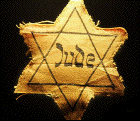
|
It
began with a
simple boycott
of Jewish shops
and ended in the
gas chambers at
Auschwitz as
Adolf Hitler and
his Nazi
followers
attempted to
exterminate the
entire Jewish
population of
Europe.
|
|
A
History of the
Jewish
Holocaust
|
|
|
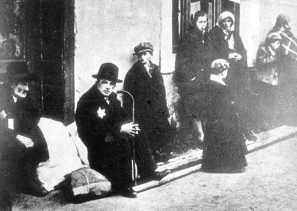
|

|
Hungarian
Jews waiting to be taken
away...
Photo
Credit: László Karsai, Ph.D.
.
|
Deportation
of Jews (1942) from Drohobycz,
Poland
Photo
Credit: Yad Vashem
|
|
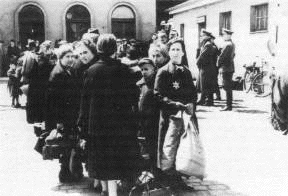
|
|

In
1942 Germany,
Jews are being rounded up for
deportation.
<bobi.net/helabo/projekte/antisem.htm>
.
|
|
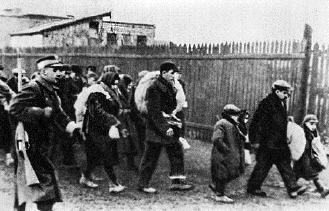
Jews carried whatever personal
belongings they could as they
left in mass deportations from
Plonsk, a town 50 miles
northwest of Warsaw, Poland.
(Photo
credit: Meczenstwo Walka,
Zaglada Zydów Polsce
1939-1945. No.65.)
.
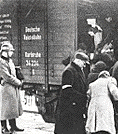
Deportation
of Jews...
.
|
|
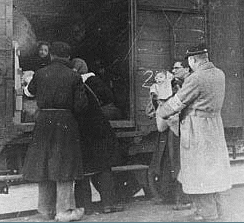
To the Death
Camps...
|
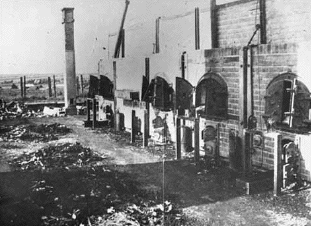
... And
to the crematoria with piles
of remains with ashes and
human bones.
(From
the crematoria at Majdanek,
extermination camp.)
|
|
Between
mid-1941 and early
1942 the Nazi's
formalized their
plan for the
annihilation of
the Jews. "The
Final Solution of
the Jewish
Question" was the
code name given by
the German
bureaucracy to
this genocide.
This was to be
accomplished
through
deportation,
ghettoization,
"special
operations
(Aktions)," the
work of the
Einsatzkommandos,
and mass-murder in
the killing fields
of the occupied
East and Soviet
Union as well as
at specially
designed killing
centers. --Florida Holocaust Museum
|
|
  
5.  The
Children of the Holocaust:
Does human evil have limits? The
Children of the Holocaust:
Does human evil have limits?
."Never
before in history had children been
singled out for destruction for no other
reason than having been born."
Dr. Paldiel
Mordecai, Yad Vashem.
|
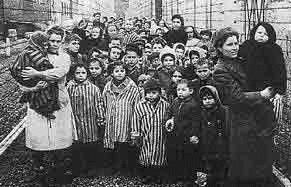
|

"We
came to the
question: what
to do with the
women and
children? I
decided to
find a clear
solution here
as well. I did
not consider
myself
justified to
exterminate
the men --
that is, to
kill them or
have them
killed -- and
allow the
avengers of
our sons and
grandsons in
the form of
their
childreen to
grow up. The
difficult
decision had
to be taken to
make this
people
disappear from
the earth."
|
|
Heinrich
Himmler, October
1943
|
|

|
...
|

|
|
|
|
Although the
Nazi plan for the murder of
all Jews was introduced in
each occupied country at
different times, the steps in
this ruthless scheme were
essentially the same. The mass
annihilation was always
preceded by a carefully
coordinated sequence:
violation of human rights,
expropriation of property,
removal from employment and
ejection to designated areas,
usually sealed ghettos or
transitory camps. Everywhere,
throughout this tragic period,
Jewish children were
confronted by overpowering,
destructive forces.
|

|
..
|
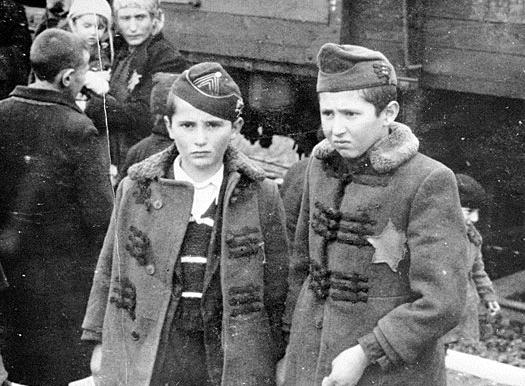
|
|
Slave
women of the Holocaust
|
Two
Hungarian brothers on
the"Death Ramp" at
Birkenau (Auschwitz
II), shortly before
they were escorted
to the gas chamber.
|

|

|
|
.
|
|

.
|
|
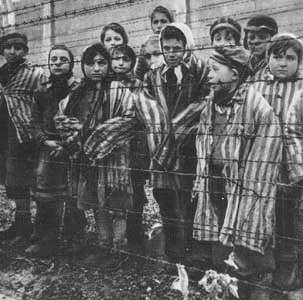
|

Some of the very
few children that survived
imprisonment in Birkenau. [Photo Archive:
Yad Vashem]

Jewish
children arriving at Chelmno
Concentration Camp from
Lodz Ghetto
|
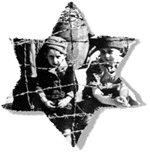
|
|
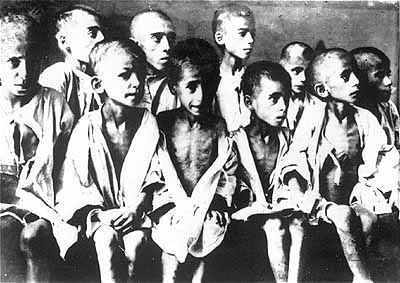
|
These
emaciated children survived
the Ravensbrück, Germany,
concentration camp. Though
Ravensbrück imprisoned mostly
women, it also included a
children's camp at Uckermark
and a separate section for
men. In December 1944 and
January 1945, Uckermark was
recognized as a selection and
extermination camp for
Ravensbrück.
At the end of
January 1945, a large
selection took place; old,
sick, or weak women were taken
to Uckermark and murdered,
many by gassing. These
selections continued into
spring, leading to the deaths
of at least 5000 women.
Photo Credit:
Musée de la Resistance
Nationale
|
|
<vaniercollege.qc.ca/events/holocaust04/children10.html>
|
  
6. The Infamous
Medical Experiments: Does human evil
have limits?
|
During World War II, Nazi doctors conducted
as many as 30
different
types of
experiments on
concentration-camp
inmates. They
performed
these studies
without the
consent of the
victims, who
suffered
indescribable
pain,
mutilation,
permanent
disability, or
in many cases
death as a
result.
At the
Nuremberg
"doctor's
trial," which
brought 23
German doctors
to trial
immediately
after the war,
prosecutors
found 15
defendants
guilty of war
crimes and
crimes against
humanity;
seven were
hung. Some of
the most
notorious
experiments
are presented
herein.
|
|
|
During
the Third
Reich, in a
step by step
process, the
Nazi doctors
went from
racial theory,
to
sterilization
of the unfit,
to euthansia,
and eventually
arrived at the
Final Solution
of the Jewish
question
--genocide.
The doctors
were
integrally
involved with
these
decisions in
every way,
from racial
laws and
diagnoses to
selections and
unethical
experimentation.
|
Deadly
Medicine:
Creating the
Master Race
(An
Online
Exhibition
from the
United States
Holocaust
Memorial
Museum)
|
Our starting point is not the individual:
We do not
subscribe to
the view that
one should
feed the
hungry, give
drink to the
thirsty, or
clothe the
naked...
Our objectives are different:
We must have a
healthy people
in order to
prevail in the
world.
Joseph Goebbels, Minister of Propaganda, 1938
|
|
|

Meet the
Infamous
Dr. Joseph Mengele


|
- Dr.
Josef Mengele -- the
Angel of Death
|
Dr
Josef Mengele,
known as the
Angel of
Death, was a
Nazi German SS
officer and a
physician in
Auschwitz Nazi
concentration
camp. He
gained
notoriety
chiefly for
being one of
the SS
physicians who
supervised the
selection of
arriving
transports of
prisoners,
determining
who was to be
killed and who
was to become
a forced
laborer, and
for performing
human
experiments of
dubious
scientific
value on camp
inmates
including
attempts to
change eye
color by
injecting
chemicals into
children's
eyes, various
amputations of
limbs, and
shock
treatments.
Most of those
Mengele
experimented
on died,
either due to
the
experiments or
later
infections. On
several
occasions, he
killed
subjects
simply to be
able to
dissect them
afterwards. --
<evilscale.com/evilscale/vote.aspx?nomineeid=92>
|

Selection
of inmates at
Auschwitz.
Mengele is in
foreground at far
right with cigarette
in hand

|
Some
four hundred
thousand souls
--babies,
small
children,
young girls,
mothers,
fathers, and
grandparents--
weree casually
waved by
Dr. Mengele
to the
left-hand side
with a simple
flick of his
cane clasped
in a gloved
hand.
|
|
When
it was
reported that
one block was
infected with
lice,
Dr. Mengele
solved the
problem by
gassing all
the 750 women
assigned to
it. Mengele
did a number
of medical
experiments of
unspeakable
horror at
Auschwitz,
using twins.
These twins as
young as five
years of age
were usually
murdered after
the experiment
was over and
their bodies
dissected.
|
|
<shoah.dk/Pics/new_page_6.htm>
|
- A
Synopsis of Dr.
Mengele's Infamous
Medical Experiments
|

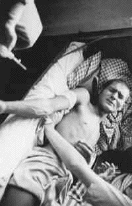
.A Romani
("Gypsy") in
a Nazi medical
experiment

|
|
|
|
  
.
7. European
Romanies/Roma/Sinti (commonly referred
as "Gypsies"), victims of the Holocaust
--the Porajmos
|
In
1933, after
Adolf Hitler
became
chancellor of
Germany, the
Nazis introduced
a law to
legalize eugenic
sterilization,
to control
population
growth among
"Gypsies and
most of the
Germans of black
colour." In
1939, the Nazi's
Office of Racial
Hygiene issued a
statement saying
"All Gypsies
should be
treated as
hereditarily
sick [...] the
aim should
therefore be the
elimination
--without
hesitation-- of
this defective
element in the
population." --- <incentraleurope.radio.cz/ice/issue/62886>
|
|
"It
was the wish of
the all-powerful
Reichsführer
Adolf Hitler to
have the Gypsies
disappear from
the face of the
earth"
|
|
(SS
Officer Percy
Broad,
Auschwitz
Political
Division)
|
|
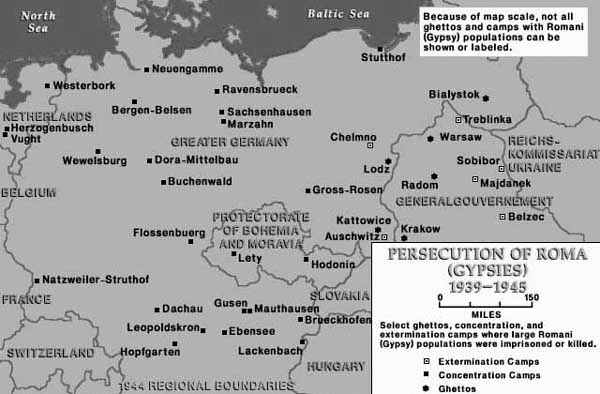
|

|
Rounding-up
Romanies ("Gypsies") for
Deporatation, Asperg,
Germany, May 22, 1940.
Source:
Deutsches Bundesarchiv
(German Federal Archive)
<commons.wikimedia.org/wiki/File:Bundesarchiv_R_165_Bild-244-47,_Asperg,_Deportation_von_Sinti_und_Roma.jpg>
|

|
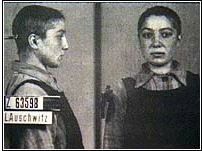
A
Romani female at Auschwitz,
name unknown,
prisoner no. Z-63598,
imprisoned October 1, 1943.
The letter 'Z' stands for
'Zigeuner' or "Gypsy."
[Auschwitz Memorial
Archives]
|
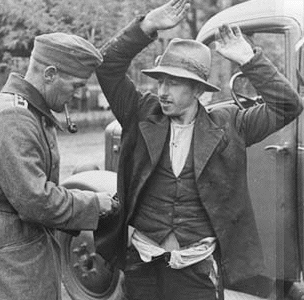
|
A Romani
("Gypsy") being searched.
His disheveled appearance
suggests that he was forced
to pull his pants down to
prove that he was not a Jew.
(Poland around 1940.)
[United
States Holocaust Memorial
Museum]

|
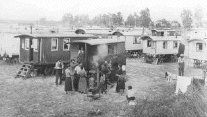
|
|
Marzahn,
the first internment camp
for "Gypsies" (Roma/Sinti)
in the Third Reich. Germany.
Marzahn camp was situated
near a sewage dump and
cemetery, and contagious
diseases flourished. 1936. [Courtesy
Landesarchiv Berlin]

|
|

|
|
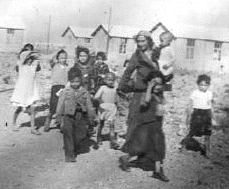
|
|
Romani
("Gypsy") women and children
interned in the Rivesaltes
transit camp. France, spring
1942. [Courtesy
USHMM]
|
  
.
|
8. The
Handicapped and the
Dissabled, Part of the
Final Solution
|
|
According
to the racial
rules of the Nazi
regime in Germany,
the worthiness of
a human being to
be allowed to
reproduce or even
to exist could be
determined by
measurable racial
characteristics.
First by means of
sterilization, and
later through
mass-murder, the
Nazi regime
practiced this
"racial science"
(through its T-4
program) to assure
the purity of the
Aryan race as well
as to gauge the
world's reaction
to genocide. -- Florida Holocaust Museum
|

|
|
  
..
9. Nazi Persecution of
Homosexuals (USHMM Exhibit)

"Just
as we today have gone back
to the ancient Germanic view
of the question of marriage
mixing different races, so
too in our judgment of
homosexuality a symptom of
degeneracy that could
destroy our race, we must
return to the guiding Nordic
principle: extermination."
|
|
Heinrich
Himmler, 1935.
|

|
|
From:
"Exhibit
Unmasking the
Nazi
Persecution of
Gays"
|
|
Homosexuals, whose "degeneracy" Nazis
believed would
taint the
Aryan German
race, suffered
horrors equal
to Jews and
Romanies
before and
during
World War II:
arrest,
imprisonment,
torture,
castration,
murder.
|
.
|
|
Heydrich
Himmler, 1938.
|
"We
must exterminate these
people, root and branch…
We can't permit such
danger to the country; the
homosexuals must be entirely
eliminated."
.
|
  
.
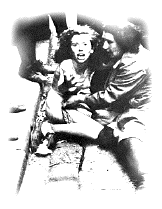
.10.
Nazi Holocaust in
the German-Occupied Europe
|
The Jews of Central and Western Europe saw themselves
as an integral
part of
society. Yet,
the Nazi
occupation
created a
reality where
the Jews were
cut off from
society in
their
countries of
residence,
thus casting
the initial
acts of
persecution
upon the Jews.
Following the
occupation,
the Jews of
France, the
Netherlands,
and other
countries were
subjected to
discriminatory
legislation
that revoked
their
citizenship
and banished
them from
economic life.
Consequently,
the Jews had
to reorganize
themselves
separately in
order to
function as a
self-sufficient
group. In the
course of
time, the Jews
in these
countries,
like those in
Germany
itself, were
forced to wear
the yellow
star or the
equivalent of
such.
Ultimately,
Nazi policy
became more
extreme and
Jews of
Central and
Western Europe
were deported
to death camps
in Eastern
Europe.
--Yad Vashem Resource Center,
<yad-vashem.org.il/odot/prog/index_before_change_table.asp?gate=2-22&type_id=22>
|
|
|
Throughout German-occupied Europe, the Germans arrested
those who
resisted their
domination and
those they
judged to be
racially
inferior or
politically
unacceptable.
People
arrested for
resisting
German rule
were mostly
sent to
forced-labor
or
concentration
camps. The
Germans
deported Jews
from all over
occupied
Europe to
extermination
camps in
Poland, where
they were
systematically
killed, and
also to
concentration
camps, where
they were used
for forced
labor. Transit
camps such as
Westerbork,
Gurs,
Mechelen, and
Drancy in
western Europe
and
concentration
camps like
Bolzano and
Fossoli di
Carpi in Italy
were used as
collection
centers for
Jews, who were
then deported
by rail to the
extermination
camps.
According to
SS reports,
there were
more than
700,000
prisoners
registered in
the
concentration
camps in
January 1945.
--Jewish Virtual Library,
<jewishvirtuallibrary.org/jsource/Holocaust/campmap.html>
|
.
|
.
- The German Occupation
of Europe
- Austria During the
Holocaust Years
- The Holocaust in
Belgium
|
Between 1942
and 1944, some 28 convoys
of 25,257 prisoners were
shipped from Malines to
Auschwitz.
Two-thirds of them died
upon arrival. Of the other
third, only 1,207
prisoners survived under
inhuman captivity
conditions.
|
-
|
|
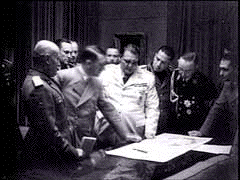
|
The
partition of
Czechoslovakia
at the Munich
Conference
presided by
Hitler
|
|
|
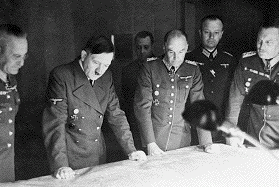
|
Hitler
with his Generals in
1941
Planning for the
Attack Against the
Soviet Union

|
|
- The Holocaust and
Denmark --A Country of Blessed
Memory
|
This
is one of the great
untold stories of World
War II: In 1943, in the
German occupied Denmark,
the Danes found out that
all 7,500 Danish Jews
were about to be rounded
up and deported to
German death camps. The
Danish people made their
own decision:
it's not going to happen ...
|
- Estonia and the
Holocaust
- France During the
Holocaust Years
|
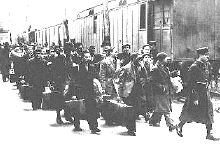
|
<<<===
Picture Left
(Paris, France;
c. May 1941):
Foreign
Jews arrested in
Paris at the
Austerlitz train
station before
deportation to
the
French-administered
internment camps
Pithiviers and
Beaune-la-Rolande
in
the Loire region.
[Courtesy:
United States
Holocaust
Memorial Museum]
|
|
.
|
Finland
During World War
II
|
|
Finland
was allied to
Germany for one
reason only: to
fight against the
Soviet occupation
of a large part of
their country.
Around 2,000 Jews
lived in Finland,
and the Finns had
no intention to
surrender them to
the Germans.
Probably due to
the very small
number of Jews,
the Germans
refrained from
pushing the issue
in the face of
Finnish
opposition. All
Finnish Jews
survived the war.
--The
Danish Center for
Holocaust and
Genocide Studies
<holocaust-education.dk/holocaust/deportationer.asp>
|
|
|
The
Jews of Finland
|
|
.The
Jews of Finland
found themselves
in a bizarre
situation with the
outbreak of World
War II. Despite
the Nazis' war on
Europe's Jews,
Finland's alliance
with Germany
caused over 300
Finnish Jews to
fight alongside
German soldiers on
the Eastern Front,
while Jewish women
served in the
country's civil
defense corps.
.Finland's
Jewish community
numbered only
about 2000
(including almost
300 refugees from
Germany and
Austria), and
antisemitism was
practically
nonexistent in the
country. Finnish
Jews had full
rights as equal
citizens. Most of
the refugees were
housed in labor
camps, where they
lived in barracks.
.When
Heinrich Himmler
broached the
subject of Finnish
Jews, the
country's prime
minister, Johann
Wilhelm Rangell,
curtly replied
that Finland had
no "Jewish
problem." Valuing
Finland's military
cooperation
against the Soviet
Union, the Nazis
applied no further
pressure.
.In
the autumn of
1942, however,
eight Jewish
refugees were
handed over to the
Gestapo.
Transported to the
extermination camp
at Auschwitz,
Poland, all but
one of the
refugees perished.
Lengthy
negotiations with
the Swedish
government secured
the transfer of
160 other refugees
to that neutral
country. The
remaining
refugees, along
with almost all
Jewish-Finnish
citizens, survived
the war--except
for a few Jewish
soldiers who died
in battle fighting
for the German
cause.
|
|
<holocaustchronicle.org/StaticPages/281.html>
|
|
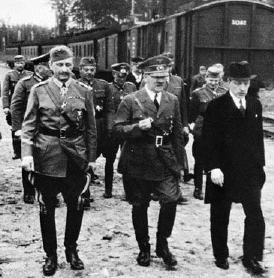
|
|
Carl
Mannerheim, Adolf Hitler and
Risto Ryti on June 6, 1942.
|
.
- The Holocaust in
Grece (from USHMM)
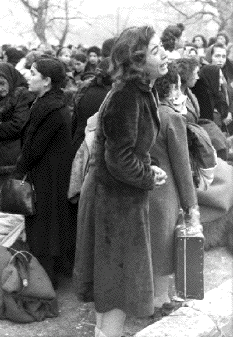
|
|

- Even though
deportations did not
start until March of
1943, Greece lost at
least 81 percent of its
Jewish population during
the Holocaust.
- Between
60,000 and 70,000 Greek
Jews perished, most of
them at
Auschwitz-Birkenau.
- Only 5,000
Jews presently live in
Greece, mostly in Athens
and Thessaloniki.
Deportation
of Jews of Ioaninna,
Greece,
on March 25, 1943,
to Auschwitz-Birkenau
<======
Ioaninna
Deportation Photographs
<kkjsm.org/holocaust/more_pictures.html>
|
|
|
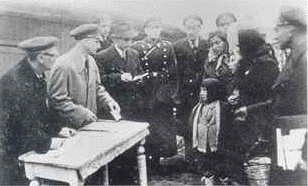
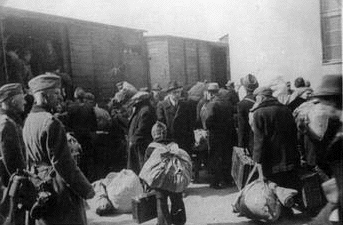
|
|
Photos Left:
Jewish
Deportations in Thrace,
March 1943
(Jewish
Museum of Greece)
and
(Yad Vashem Archives)
|
|
|
<yadvashem.org/Odot/prog/image_into.asp?id=951&lang=EN&type_id=&addr=/IMAGE_TYPE/951.JPG>
|
.
|
H
U
N
G
A
R
Y
|
The
Holocaust in
Hungary --a
Willing
Participant and
Ally of Nazi
Germany
.
|

|
|
.Horthy
(the Hungarian head
of State, 1920-1944)
with Hitler in 1938.
|
|
H
U
N
G
A
R
Y
|
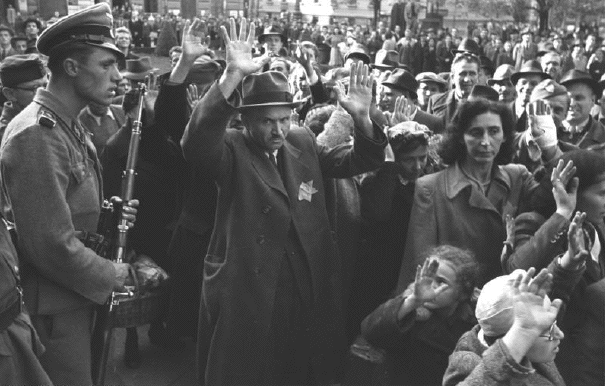
|
|
The
SS Rounding up the
Hungarian Jews of
Budapest, October,
1944, at the
Delight of
non-Jewish
Civilians
|
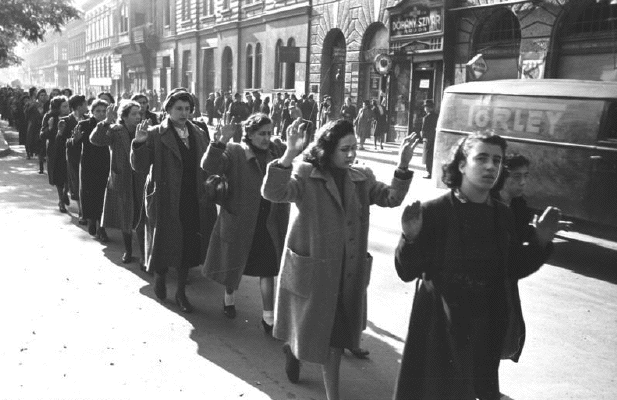
|
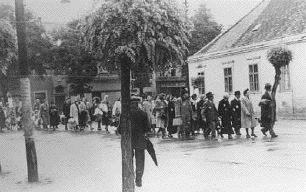
|
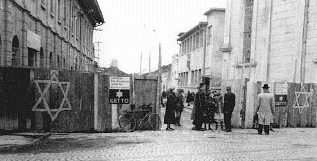
|
Guards
check the
identification
papers of women
entering the
ghetto in Munkacs,
in a part of
Czechoslovakia
annexed by Hungary
in 1938.
Czechoslovakia,
1944.
Photo
Credit: Beit
Lohamei Haghettaot
|
Deportation
of Hungarian Jews.
Koszeg, Hungary,
May 1944.
Photo
Credit: Magyar
Nemzeti Muzeum
Torteneti
Fenykeptar
|
|
.
|

|
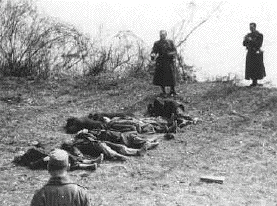
|
Members
of the fascist
Arrow Cross Party
arrest Jews.
Budapest, Hungary,
October-December
1944.
United
States Holocaust
Memorial Museum
|
Arrow
Cross Party
members execute
Jews along the
banks
of the Danube
River. Budapest,
Hungary, 1944.
National
Archives and
Records
Administration,
College Park, Md.,
USA.
|
|
|
.
|
.
-
Italy and the
Holocaust
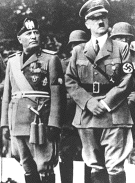
|
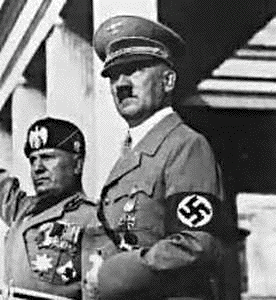
|
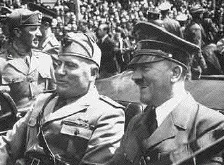

Mussolini
and Hitler
ride in an open
car through the
streets of
Munich during
the Italian
dictator's
visit to Germany
|
|
- The Holocaust in
Luxembourg (from
USHMM)
|
Only 36 Jews from
Luxembourg are known to have
survived the Nazi camps.
|
|
Estimates of the
total number of Luxembourg Jews
murdered during the Holocaust
range from 1,000 to 2,500. These
figures include those killed in
Nazi camps, in Luxembourg, or
after deportation from France.
|
- The Holocaust in
Macedonia: Deportation of Monastir Jewry
-
Introductory Note on
"The Destruction of the Jews of The
Netherlands"
T
H
E
N
E
T
H
E
R
L
A
N
D
S
A
N
D
T
H
E
H
O
L
O
C
A
U
S
T
|
|
On
May 10, 1940,
German troops
invaded The
Netherlands.
Five days
later, Dutch
forces
surrendered
and the German
occupation of
The Netherlands
officially
began. Five
years later,
The
Netherlands
would be
liberated. The
persecution
and the
destruction of
the Jews
during those
five years was
enormous
indeed.
|
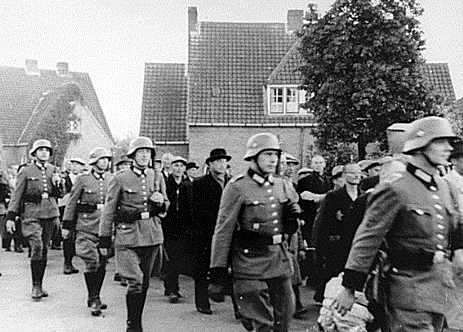
Dutch
Jews are
marched under
heavy guard to
the Amersfoot
Internment
Camp in 1942.
[Photo
credit:
Rijksinstituut
voor
Oorlogsdocumentatie]
<historyplace.com/worldwar2/holocaust/h-dutch.htm>
Anti-Semitic
Graffiti in
the Amsterdam
of 1942.
<lib.usc.edu/~anthonya/holo.htm>
.
|
|
A
railway
station in
Amsterdam
Dutch
Jews being led
to the trains
that will take
them to a
transit camp.
Between
July 1942 and
September
1944, 115,000
people were
deported,
mainly to
Auschwitz and
Sobibor.
Almost
all were
killed.
|
|

|
|
<friends-partners.org/partners/beyond-the-pale/eng_captions/52-3.html>
|
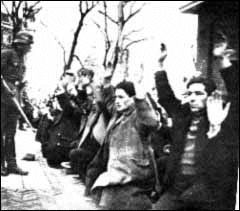
Dutch Jewish
men rounded up by German
soldiers at the height of
theNazi terror
in Amsterdam, The
Netherlands.
<project-roots.com/warmemories.html>
|
70% of the Jews in Holland perished in
the Holocaust.
This 70%
figure
represents the
highest loss
in any country
occupied by
the Germans in
western
Europe.
|
|
.
N
A
Z
I
N
O
R
W
A
Y
|
Norway During
the Holocaust Years
|
H
O
L
O
C
A
U
S
T
|
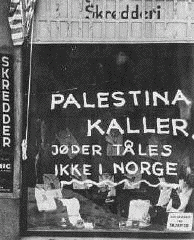
|
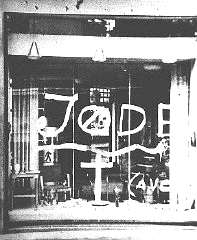
|
|
On a Jewish-owned
shop,
Norwegian fascists painted the
slogan:
"Palestine is calling. Jews
are not tolerated
in Norway."
|
Antisemitic
graffiti on the window of a
Jewish-owned store.
|
|
Norway,
after April 1940.
|
|
United
States Holocaust Memorial Museum
|
.
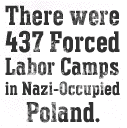
|
|
The
Anti-Semitic Poland and the
Holocaust
The
Catholic Church in Poland
and the Holocaust, 1939 -
1945
An
examination of the behavior of
the Polish Church leaders in
Occupied Poland. -- from Yad Vashem
The
Holocaust in Poland:
On the
Extermination of Jews in
Poland
Nazi German
Camps on Polish Soil During
World War II
Aktion
Reinhard (Operation
Reinhard)
From Yad
Vashem: Aktion Reinhard
"Operation
Reinhard":
The
Extermination Camps of
Belzec, Sobibor and
Treblinka
The Jews of
Tarnow, Poland During the
Holocaust
.
|
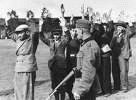
Jewish Poles being rounded
up
(USHMM
Photo Archive )
<holocaust.cz/cz2/history/jew/general/general7>
+
|
.
|
.
|
|
.
|
|
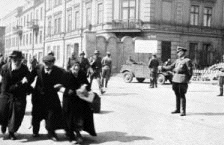
|
|
The
first deportation
of Jews from
Krakow,
30 May -- 8 June 1942.
They were shipped
in cattle trucks
to Belzec death
camp in Eastern
Poland, where
500,000 died or
were killed until
the camp was
decommissioned in
March 1943.
(The Ghetto wall
is in background.)
<birdbattlefieldtours.com/sub_holocaust.htm>
|
|

|
P
O
L
A
N
D
|
|
Under guard,
Jewish men, women, and
children board trains during
deportation from Siedlce to
the Treblinka extermination
camp. Siedlce, Poland, August
1942.
|
|
--
Dokumentationsarchiv des
Oesterreichischen
Widerstandes
|
|
.
|

|
A
village execution of Jewish
Poles by a German squad
Dokumentationarchiv
des Oesterreicheischen
Widerstandes --
<britannica.com/eb/art-58217>
.
|
.
.
.Spain
During the Holocaust Years
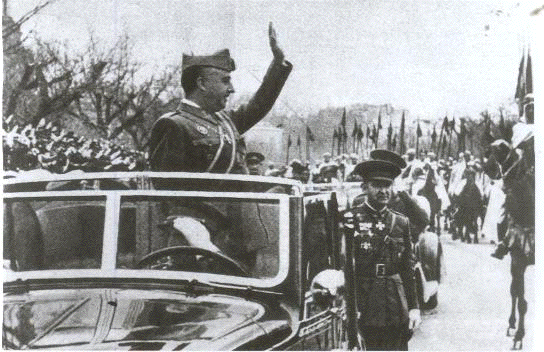
|
|
Generalissimo
Francisco Franco, Spain and
the Holocaust
|
|
Although
Spain's head of state,
Generalissimo Francisco
Franco, sympathized with the
Axis powers, his political
policies saved an estimated
17,000 Jews from death camps.
Franco refused to enter the
war. Instead, he declared
Spain a "nonbelligerent," and
during the latter half of the
war changed the country's
status to "neutral."
Franco
frustrated the SS by declaring
descendants of Sephardic Jews
eligible for Spanish
citizenship, and thus entitled
to asylum in Spanish
embassies. Spain consequently
became a main avenue of escape
for Europe's Jews. Some hoped
to find asylum within the
country, but most intended to
embark from Spanish ports for
sanctuary overseas.
The fall of
France in 1940 unleashed a
flood of refugees seeking
entry into Spain. Initially,
the Spanish government
willingly granted transit
visas, but then authorities
became more hesitant to open
frontiers. Still, many
refugees slipped across the
northern border illegally,
trekking over hazardous
mountain routes. By the summer
of 1942, Jewish aid
organizations helped an
estimated 7500 pass through
Spain to continue their
journeys.
Spanish
authorities worked to
discourage refugees from
remaining in the country, and
established internment camps
for those who did. When border
crossings increased again in
1943, refugees were permitted
to live in Spanish cities.
|
The
Holocaust Chronicle, page 331
<holocaustchronicle.org/staticpages/331.html>
|
- Sweden and the
Holocaust
.
|
.
|


|
|
From
the Eizenstat
Report:
|
|
|
|
"Switzerland
was a critical
trading
partner of
Nazi Germany.
Its exports of
ball bearings
to Germany
were vitally
important
during the
war, and for a
time
Switzerland
supplied
Germany with
40 percent of
its iron ore
until other
European
sources
reduced that
dependency."
|
|
.
|
.
|
The
Holocaust In Yugoslavia:
|
|
|
|
.
|
  
.
  
.
12. The Nazi Ghettos:
The Ghettoization of European Jewry
|
.
|
|
Hundreds
and thousands of
Jews were
confined in
ghettos
throughout
Europe as the
Nazis sought to
contain the
Jewish
population in
preparation for
the Final
Solution. While
Ghetto
inhabitants
tried to sustain
a certain degree
of normalcy in
their lives,
(through
cultural and
social
activities)
living
conditions were
terrible, and
thousands died
from hunger and
disease.
|
|
--Florida
Holocaust Museum
|
|
|
.
|
|
The
Daily Struggle for Survival
in the Ghettos
|
|
Individual
Jews and the
society as a
whole struggled
to maintain some
quality of life
even under the
most difficult
circumstances.
In Eastern
Europe, this was
known as
Iberleben
--which is
Yiddish for
survival. Many
Jews tried to
survive by
holding on to
jobs beneficial
to the Nazi
regime. This
concept of
'rescue by
labor' was
perceived as
something that
could keep
people alive for
a while. It also
gave these Jews
a minimal
livelihood, but
this was always
dependent on the
willingness of
the German
authorities. At
the same time
the Jews in the
ghettos were
contending with
physical
difficulties
such as
starvation. They
combatted this
by smuggling in
food and
medicine to the
ghetto.
|
|
--Source:
Yad Vashem --
<yad-vashem.org.il/odot/prog/index_before_change_table.asp?gate=2-49>
|
|
.
|
|
Bialystok, Brody,
Czestochowa, Grodno, Jaworow,
Kielce, Kolomyja, Krakow,
Krasnystaw, Lodz, Lubartow,
Lublin, Lvov, Miedzyrzec
Podlaski, Minsk, Piotrkow
Trybunalski, Przemysl, Radom,
Radomsko, Rawa Ruska, Rzeszow,
Siedlce Tarnow, Tomaszow
Mazowiecki, Vilnius, Warszawa
(Warsaw), Zamosc, Zwolen.
|
|
.
|
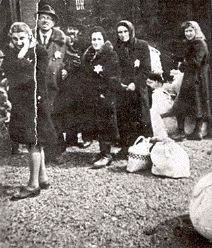
|
|
Jews being
brought to Kosice,
Czechoslovakia from
surrounding villages on April
17, 1944. Deportations to
Auschwitz began on May 15; the
final transport of Jews from
Kosice was sent on June 3,
1944. [Yad
Vashem Archive]
|
.
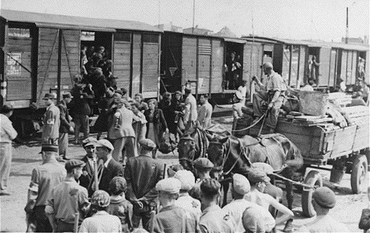
Jews from
the Lodz ghetto are
loaded onto freight
trains
for deportation to the
Chelmno extermination
camp. Lodz, Poland,
between 1942 and 1944.
[National
Museum of American
Jewish History,
Philadelphia, USA]
.
|
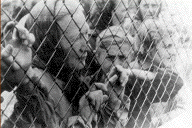

[Yad
Vashem Archives #
40AO4]
|
- The
Lodz Ghetto
This is
a photograph of
children standing
behind the ghetto
fence in Lodz,
Poland, on August
15, 1944. From
January to May,
1942, 55,000 Jews
were sent to their
deaths in Chelmno
death camp. From
September 1942 until
May 1944 there were
no more
deportations. After
May, the
deportations to
Chelmno were
renewed. In early
August, the Nazis
rerouted the
deportations to
Auschwitz. By August
30, 1944 about
70,000 Jews from
Lodz were sent to
Auschwitz.
|
.
|
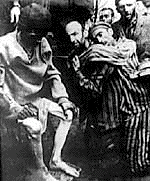
|
|
|
|
Survivors,
near to their death, at Wöbbelin
-- <frihed.natmus.dk/rundvisninger/kz3.htm>
|
  
13. .The
Concentration and Extermination Camps
|
There
were 11 major Concentration
Camps:
|
Dachau
Sachsenhausen
Ravensbruck
Buchenwald
Flossenburg
Neungamme Gross
Rosen Natzweiler
Mauthausen
Stutthof
Dora / Nordhausen
|
|
There
were 4 main Killing Centres:
|
Belzec
Chelmno
Sobibor
Treblinka
|
|
There
were 2 main Labor /
Extermination Camps:
|
Auschwitz/
Birkenau
Majdanek (KZ Lublin)
|
|
There
were 2 main Holding Centres:
|
Bergen-Belsen
Theresienstadt
(Terezin)
|
|
There
were hundreds of Labor
Camps:
|
Over
400 Labor Camps only in the
occupied Poland, such as
Poniatowa, Trawniki, Budzyn,
Plaszow
|
|

|
<martinfrost.ws/htmlfiles/holocaust.html>
.
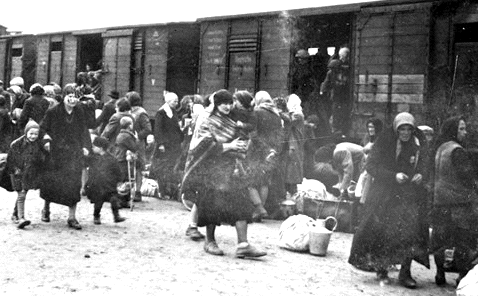
Jews from Carpathian Ruthenia
get off the deportation train and assemble
on the ramp at Auschwitz-Birkenau.
[From Yad Vashem --The
Holocaust Martyrs' and Heroes' Remembrance
Authority.]
<kcl.ac.uk/depsta/iss/library/speccoll/bomarch/bomaug06.html>
..
|
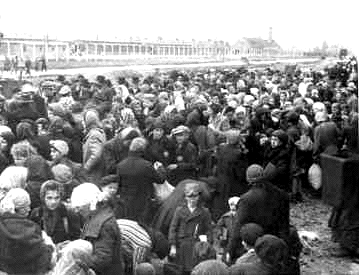
.A new Jewish
transport that just arrived at
Birkenau-Auschwitz in 1944
Crematorium II (Krema II) can
be seen in the rear at right.
.
|
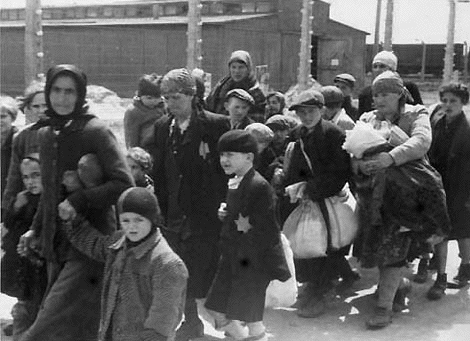
|
.At Birkenau
Selected, Upon Arrival, For
the Gas Chamber
(Their
only "crime" was the they were
born Jewish.)
|
|

|
|

Meet the
infamous
SS Maria
Mandel .
|
 Crematorium IV
(Krema IV) in
Birkenau-Auschwitz. The gas
chambers are in the back; in
the foreground, the morgue and
the crematorium. Crematorium IV
(Krema IV) in
Birkenau-Auschwitz. The gas
chambers are in the back; in
the foreground, the morgue and
the crematorium.

|
.
|
|
|
Belzec, one of the Nazis death camps associated with
Action
Reinhard, was
opened in
November 1941.
Belzec was in
the southeast
corner of
Poland, and
like
Auschwitz-Birkenau,
Treblinka and
Sobibor, was
in a remote
sight, away
from prying
eyes. Belzec
began its
murders in
March 1942 and
it closed in
December 1942.
Belzec was
responsible
for up to
600,000 deaths
in the
Holocaust.
.The
original camp
at Belzec has
been a labour
camp and had
been opened in
1940.
Labourers held
here and local
Jews were used
to convert the
camp into a
death camp.
The first
commander of
Belzec death
camp was
Christian
Wirth, a SS
officer.
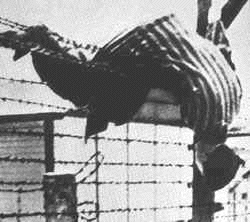 . Initially
at Belzec
there were
three gas
chambers in
use. This was
later
increased to
six to cope
with the
increased
human traffic
that was being
sent to the
camp. Unlike
Auschwitz,
which covered
a large area,
Belzec was
reasonably
small. A rail
spur led
directly to
the camp. One
part of the
camp was used
to store the
clothes and
valuables
taken from the
victims sent
there. Another
separate part
of the camp
held the gas
chambers and
burial pits.
The two
sections were
connected by
what was known
as "The Tube"
--a narrow
passageway
topped with
barbed wire.
Branches,
taken off
nearby trees,
were
interwoven
into the
barbed wire to
screen it off
from the
camp's other
section. . Initially
at Belzec
there were
three gas
chambers in
use. This was
later
increased to
six to cope
with the
increased
human traffic
that was being
sent to the
camp. Unlike
Auschwitz,
which covered
a large area,
Belzec was
reasonably
small. A rail
spur led
directly to
the camp. One
part of the
camp was used
to store the
clothes and
valuables
taken from the
victims sent
there. Another
separate part
of the camp
held the gas
chambers and
burial pits.
The two
sections were
connected by
what was known
as "The Tube"
--a narrow
passageway
topped with
barbed wire.
Branches,
taken off
nearby trees,
were
interwoven
into the
barbed wire to
screen it off
from the
camp's other
section.
. Wirth
ensured that
the guards
there worked
effectively.
When a train
arrived at
Belzec, it
would usually
have 2000 to
2,500 Jews in
the trucks.
When they had
disembarked
from the
trucks, the
Jews were
split into two
to three
groups. They
were then made
to enter the
camp. Having
been told that
they needed to
shower before
starting
labour duties,
the Jews were
forced through
"The Tube" and
then to the
gas chambers.
The process of
mass murder
took about 30
minutes
--Belzec used
carbon
monoxide gas
piped in from
a diesel
engine. Other
Jewish
prisoners --
the
Sonderkommando--
were made to
clear the gas
chamber of
bodies and to
extract gold
teeth etc.
Other teams of
Jews were used
to tidy and
sort the huts
where the
victims had
taken off
their clothes
etc. It took
about three
hours to kill
and then clean
up one
trainload of
Jews.
. When
the number of
gas chambers
at Belzec was
doubled, a
whole
trainload of
Jews could be
split in two
and then
"processed"
(Wirth). The
six gas
chambers could
take 1,200
Jews; the
three-hour
process was
greatly
reduced in
time. However,
as more were
being murdered
at one time,
the SS needed
more Jews to
work as
Sonderkommandos.
At Belzec, in
the second
stage of its
existence with
six gas
chambers,
there were
1000
Sonderkommado.
Those still
alive when the
camp stopped
being used
were sent to
Sobibor to be
murdered.
. As
with all the
death camps,
exact figures
of deaths are
impossible to
acquire. Many
documents of
what went on
at Belzec were
either
destroyed at
the camp or
sent to Berlin
where they
were also
lost. It is
thought that
600,000 Jews
were murdered
at Belzec
along with
12,000
Romanies
(Gypsies).
. When
it stopped
operating in
December 1942,
the area where
Belzec had
been was
ploughed over
and turned
into a farm.
|
|
<.historylearningsite.co.uk/belzec.htm>
|
|
|
.
|
|
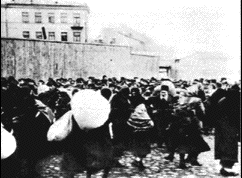
Photo:
A new arrival of Jews
at Belzec Death
Camp
Photo
Credit:
<clas.ufl.edu/llc/Sommerschule/Myers.htm>
|
|
|
- Berga Concentration Camp,
Weimar, Germany
-

.Bergen-Belsen
on April 15, 1945.
<kz-zuege.de/kapitel_05.htm>
|

|
One of the Very Few Survivors
of the
Bergen-Belsen
Death Camp
|
|
|
|
|
.
- Bogdanovka
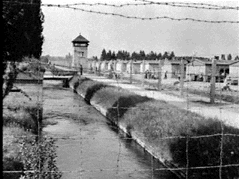
|
(in Romanian,
Bogdanovca), camp located on the
Bug River, in the village of
Bogdanovka in Transnistia. It
was established in October 1941
by the Romanian occupation
authorities. By December 1,
1941, over 54,000 Jews from
Bessarabia and Odessa were
imprisoned in the camp. In
mid-December, typhus broke out
in Bogdanovka. At that point,
the Romanians and Germans
decided to destroy the entire
camp population. The
extermination began on December
21. Romanian soldiers and
police, Ukrainian police, and
local civilians took part, under
the command of the local
Ukrainian police chief.
Approximately 5,000 sick and
handicapped prisoners were
locked into two stables which
were then burnt down. The rest
of the prisoners were marched in
groups of 300--400 to the river.
They were forced to remove their
clothing and kneel. Then they
were shot or hit with hand
grenades. The killing continued
for four days, during which
30,000 Jews were murdered. The
killing was stopped temporarily
on Christmas Eve, while the
remaining Jews were left
outside, freezing and waiting to
die. The massacre began again on
December 28; 11,000 Jews were
killed by December 31. Two
hundred were kept alive to burn
the bodies, after which most of
them were either killed or died
from exposure. [Source: Yad
Vashem]
|
.
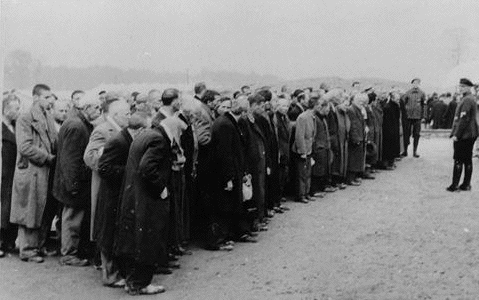
A New
Arrival of Jews at
Buchenwald
<www.gesch.med.uni-erlangen.de/gewissen/ausstell/hinter/text_02.htm>
(United
States Holocaust
Memorial Museum)
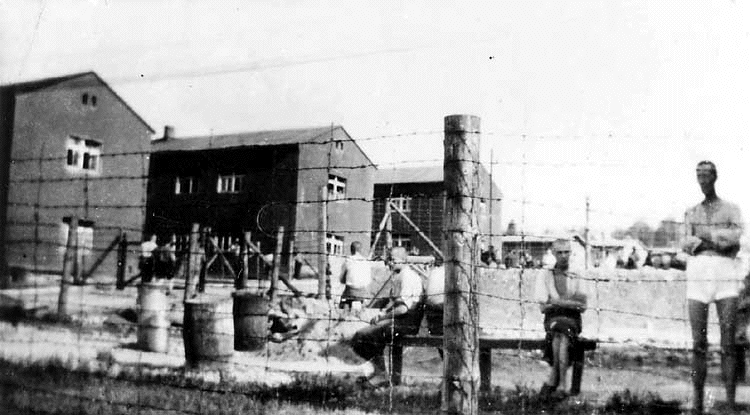
Buchenwald's
main camp taken
secretly by detainee
Georges Angéli in
June, 1944. [spegel.de]
|
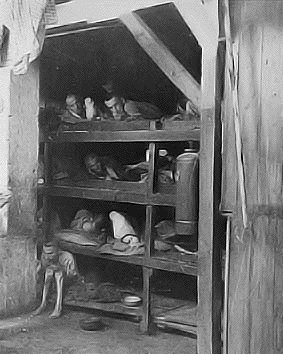
<secondeguerre.net/hisetpo/bh/hp_campsconext.html>
|
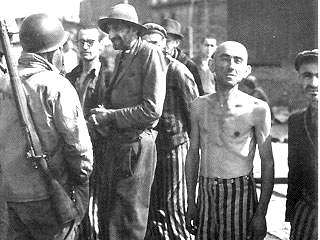
<kriegsende.ard.de/pages_magnifier/0,3273,OID1145578_CON1157224_POS3,00.html>
|

|
|
Margaret Bourke-White's photo for Life magazine at
Buchenwald,
1945
|
|
Margaret
Bourke-White
was with
General
Patton's third
amy when they
reached
Buchenwald on
the outskirts
of Weimar.
Patton was so
incensed by
what he saw
that he
ordered his
police to get
a thousand
civilians to
make them see
with their own
eyes what
their leaders
had done. The
MPs were so
enraged they
brought back
2,000.
Bourke-White
said,
"I saw
and
photographed
the piles of
naked,
lifeless
bodies, the
human
skeletons in
furnaces, the
living
skeletons who
would die the
next day...
and tattoed
skin for
lampshades.
Using the
camera was
almost a
relief. It
interposed a
slight barrier
between myself
and the horror
in front of
me." LIFE
published in
their May 7,
1945 issue
many
photographs of
these
atrocities,
saying,
|
|
"Dead men will have indeed died in vain if live men
refuse to look
at them."
|
.
|

<www.uiowa.edu/policult/politicalphotos/holocaust2.html>
|
|
|
Buchenwald
at Liberation, April
1945.
|
|
- "Operation Reinhard":
The Extermination Camps
of Belzec, Sobibor and Treblinka
.
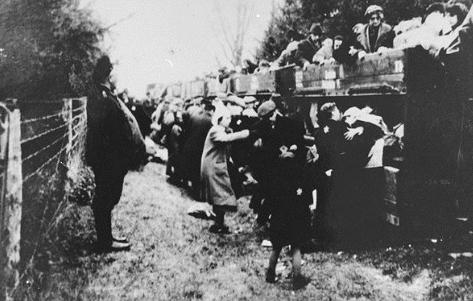
|
|
Jewish
deportees from the Lodz
Ghetto arrive in Chelmno
Extermination Camp.
|
- Chelmno - Death Camp
for Total Extermination
.
.Gusen
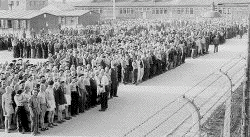
|
|
Prisoners
at Gusen --
<gusen.org>
|
KZ Gusen
II: The "Hell of Hells"
|
The
Jews belonged to
the lowest group
in the
KZ Gusen
hierarchy. They
had to do the
worst jobs and
often survived
just for a few
working-days in
that
"Hell of Hells."
|
|
The
inmates lacked
housing, food and
clothing, as well
as drinking water
in the
KZ Gusen II.
The only water was
pumped in from the
nearby
Danube River
and it was
suicidal to drink
it.
|
|
In
winter 1944/45 so
many transports
came to
KZ Gusen II
via its direct
railway-connections,
that the SS
decided to
exterminate the
transportees, who
were possibly from
KZ Auschwitz,
by keeping them
inside the
railway-cars at
below zero
temperatures. In a
matter of a days
all of them were
frozen to death on
the rails between
St.Georgen and
KZ Gusen II Station.
|
|
"As a
resident of many
camps, I can say
that Guzen was the
worst. This is not
to say that the
conditions at the
other camps were
not dreadful.
Compared to Guzen,
however, one might
almost say that
those camps were
paradises. The
proof of this
might be that
Guzen was one of
the least known
camps. This was
not because it was
smaller than the
others - it might
even have been the
largest. It was
unknown simply
because very few
of the tens of
thousand of
prisoners sent
there remained
alive to tell the
story of its
horrors."
--Rabbi
RAV YECHEZKEL
HARFENES -- <gusen.org>
|
.
|
.
.
|
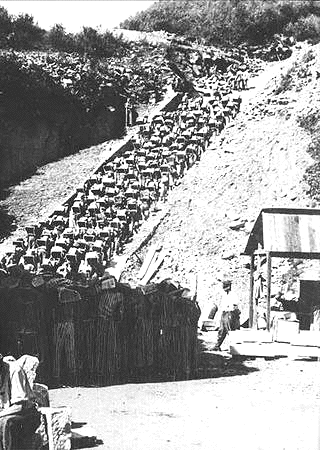
|
The
prisoners of
Mauthausen-Gusen
concentration
camp climb the
infamous
Stairs of
Death with
heavy stones
on their
backs.
<answers.com/topic/mauthausen-gusen-concentration-camp>
|
.
|
|
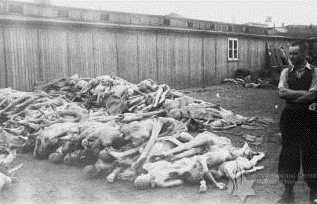
Mauthausen
Pile of Corpses at
Liberation
|
|
.
-
|
Neuengamme
(Germany) Concentration Camp
|
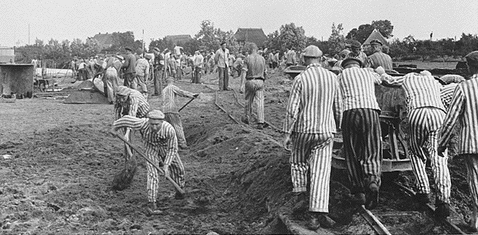
|
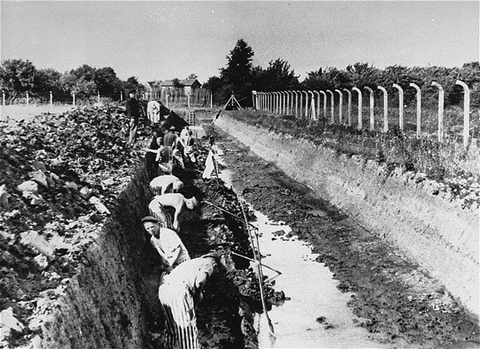
|
Prisoners
at forced labor in the
Neuengamme concentration camp
building the Dove-Elbe canal.
(1941 - 1942)
(The
Kapos wear white and black
armbands in the 1st picture
above.)
|
[Photographs
from the KZ-Gedenkstatte
Neuengamme, courtesy of USHMM
Photo Archives]
<history1900s.about.com/library/holocaust/blneuen1.htm>
<history1900s.about.com/library/holocaust/blneuen9.htm>
|
- Nordhausen
Concentration Camp
(A Sub-camp of
Dora-Mittelbau)
 Ohrdruf Camp
(subcamp of the Buchenwald Concentration
Camp)
Ohrdruf Camp
(subcamp of the Buchenwald Concentration
Camp)
--the first Nazi camp
liberated by U.S. troops
- Gross-Rosen
Concentration Camp
(established in 1940 as
a subcamp of the Sachsenhausen
Concentration Camp)
.
- Sachsenhausen
Concentration Camp
--Oranienburg (Germany)
Just
outside the city limits
stands a reminder of the
darkest days of Berlin's
history: Sachsenhausen.
Built in 1936 by slave
laborers from other early
camps, Berlin's
concentration camp became a
model of the designed
efficiency for all those to
follow, and by the end of
WWII, over 50,000 people had
lost their lives to the Nazi
death machine. Sachsenhausen
was more than just a camp:
it was a school of brutality
training guards for
positions at all other
camps.
|

Homosexual
prisoners
at Sachsenhausen.

|
|
.
..
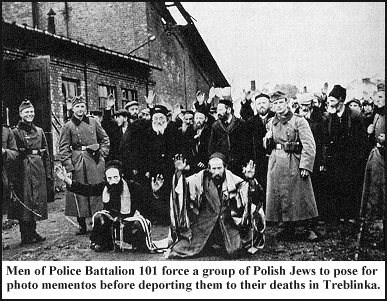
<historyplace.com/pointsofview/goldhagen.htm>
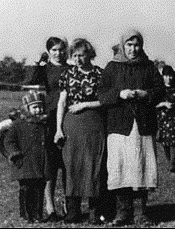
|
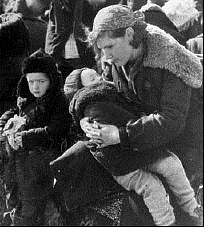
|
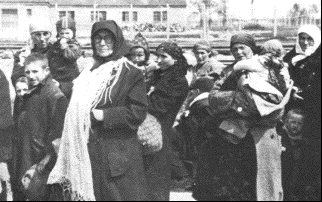
|
|
Ukrainian
Jews assembled for mass
execution
|
Hungarian
women and children to be gassed
in Auschwitz
after having been deemed unfit
for work
|
- Shoah (Holocaust):
Primary Documents
- JewishGen's Holocaust
Database
- Defendants in the
Major War Figures Trial
- Convicting the Nazis
on their Own Evidence
Comprehensive Index:
- The Nazis / Nuremberg War Crimes Trial
- Testimony / Documents and Other
sources
|
"A
thousand years will pass and
the guilt of Germany will
not be erased." --Oct 16, 1946.
|
|
|
Hans
Frank [Governor of occupied
Poland], convicted of major
Nazi war criminal at
Nuremberg.
|
- The Auschwitz Trials
- Auschwitz
Concentration Camp
by SS Pery Broad
--Member of the SS Personnel in
Auschwitz Concentration Camp
- First-Hand Documents
of the Holocaust in Poland from Yad
Vashem
- Nazi's Euthanasia
files are made public
- Legendary American
Reporter Edward R. Murrow Describes
Buchenwald
(when he entered the camp after
liberation)
- United States War
Refugee Board Receives Report on Final
Solution
- The "Captured German
Records" Holocaust Collection
- German/Austrian
Holocaust Related Databases on the Web
- Photographs
Documenting the Holocaust in Hungary
- Heinrich Himmler'
Speech of October 4, 1943
- Large Theresienstadt
documentation, 1943-1945
- More Theresienstadt
Ghetto Documents
- Minutes of the
Wannsee Conference
- The Execution of
Children and Women
- Photographs
Documenting the Holocaust in Hungary
by László Karsai, Ph.D.
- The Hadamar Trial.
Trial of Alfons Klein and Six Others.
United Nations War Crimes Commission,
1947
- Eyewitness Accounts:
Description of Concentration Camps
- Diary of Dr. Johann
Paul Kremer
- Testimony of Saraleh
Batscha (née Mondula) of Cluj,
Transylvania (now, part of Romania) of
the life in Auschwitz
- Photographs from
Belsen Concentration Camp: Victims,
Perpetrators, Liberators
- Excerpts From
Testimonies of SS Men, with Sources
- Primary Documents:
Nazi Extermination of
People with Mental Disabilities
- Documentation of The
Mass Murder of Lithuanian Jewry by the
SS Einsatzgruppen -- "Action Groups"
from a Secret Reich Letter
- The Jaeger Report: A
Chronicle of Nazi Mass Murder:
One Unit, One Area, Five Months - and
137,000 Victims
- Letter from
SS-Sturmbannfuehrer Jahrling to
SS-General Kammler where
the cremating
capacity of the five Auschwitz
crematoriums is specified as 4,756 per
24 working hours
|
|
|
|
"I
myself never shot a
single Jew;
I only gassed
them..."
Erich
Gnewuch
|
.
|
|

|
|
Polish
survivor Jadwiga
Dzido shows her
scarred leg to the
court, while expert
witness Dr.
Alexander explains
the nature of the
medical experiment
performed on her in
the Ravensbrück
concentration camp.
Dzido and Alexander
were appearing as
witnesses at the
Doctors Trial.
|
..
|


|
Nuremberg
Trials [Harvard
University Law Library]
(Repository
of some one million Trial pages)
|
Two United States
Historic Photographs:
.Dwight D.
Eisenhower with other US
Officers at Ohrdruf,
a subcamp of the Buchenwald
concentration camp,
After Liberation
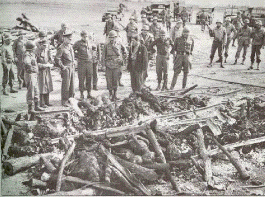 
 

|
|
A
collection of
over 4,300
videotaped
interviews
with witnesses
and survivors
of
the Holocaust
that is part
of
|
|
Sterling
Memorial
Library, Yale
University,
New Haven,
Connecticut,
USA.
|
|
|
  
.
.15.
Nazi Plundering
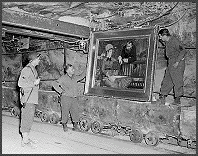
|
|
A
painting by the French
impressionist Edouard Manet,
titled "Wintergarden",
discovered in the vault at
Merkers.
April 25, 1945 [+Enlarge Picture]
|
|
European
Center of Military History -
Belgium
|
|
Documentation
from the United States
National Archives and
Records Administration
(NARA):
|
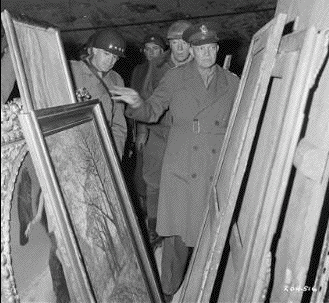
|
General
Dwight D.
Eisenhower,
Supreme Allied
Commander,
accompanied by
General Omar
Bradley and
Lt. Gen. George
Patton, Jr.,
inspects stolen
art treasures.
|
|
.
|
|
|
.
|
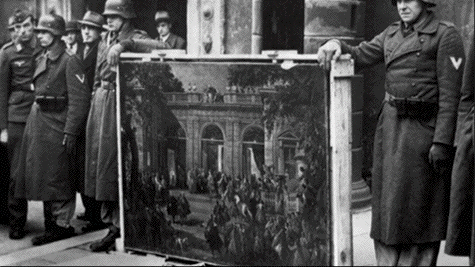
|
|
THE RAPE
OF EUROPA tells the
epic story of the systematic
theft, deliberate destruction
and miraculous survival of
Europe's art treasures during
the Third Reich and World War
II. In a journey through seven
countries, the film takes
viewers into the violent
whirlwind of fanaticism,
greed, and warfare that
threatened to wipe out the
artistic heritage of Europe.
For twelve long years, the
Nazis looted and destroyed art
on a scale unprecedented in
history. But heroic young art
historians and curators from
America and across Europe
fought back with an
extraordinary campaign to
rescue and return the millions
of lost, hidden and stolen
treasures. Now, more than
sixty years later, the legacy
of this tragic history
continues to play out as
families of looted collectors
recover major works of art,
conservators repair battle
damage, and nations fight over
the fate of ill-gotten spoils
of war.
|



.
|
|
Suggestions for further
material to be included in here are welcome.
|


|
|
Holocaust Remembrance,
Sanctuary, and Beyond ...
|
.
|

